NCERT Exemplar Solutions for Class 10 Science Chapter 7 Control and Coordination
These Solutions are part of NCERT Exemplar Solutions for Class 10 Science. Here we have given NCERT Exemplar Solutions for Class 10 Science Chapter 7 Control and Coordination
NCERT Exemplar Solutions for Class 10 Science Chapter 7 Short Answer Questions
Question 1.
- Label the parts a, b, c and d and show the direction of electrical signals in the figure. (CBSE 2010)
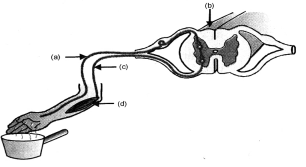
- Draw the figure shown here and label motor neuron, relay neuron and spinal cord. What is the name of this connection ?
(CCE 2011)
More Resources
- NCERT Exemplar Solutions for Class 10 Science
- NCERT Solutions for Class 10 Science
- Value Based Questions in Science for Class 10
- HOTS Questions for Class 10 Science
- Previous Year Question Papers for CBSE Class 10 Science
Answer:
- a – Sensory neuron.
b – Spinal cord (CNS).
c – Mortor neuron.
d – Effector (muscle in arm) - Name — Reflex arc.
Direction :- Receptor (hand) to spinal cord through sensory neuron,
- Sensory neuron to motor neuron through Spinal cord to effector through motor neuron.
Question 2.
Name the plant hormone responsible for the following :
(a) Elongation of cells
(b) Growth of stem
(c) Promotion of cell division
(d) Falling of senescent leaves.
Answer:
(a) Elongation of Cells. Auxin.
(b) Growth of Stem. Gibberellin.
(c) Promotion of Cell Division. Cytokinin.
(d) Falling of Senescent Leaves. Abscisic acid.
Question 3.
Label the endocrine glands in the figure
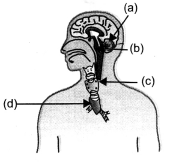
Answer:
a – Pineal gland.
b – Pituitary gland.
c – Thyroid
d – Thymus.
Question 4.
In the figures (a), (b) and (c) which appears more accurate and why ?

Answer:
Figure (a) is more accurate as it shows appropriate response of both shoot and root to the vector of gravity. Shoot is negatively geotropic. It, therefore, bends upwardly. Root is positively geotropic. It, therefore, bends downwardly.
Question 5.
Label the parts of a neuron shown in the figure.
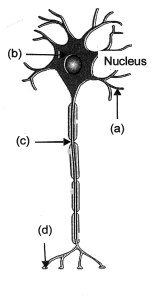
Answer:
a – Dendrite.
b – Cyton (Cell body).
c – Axon.
d – Axon terminal (bouton).
Question 6.
Match the terms of column A with those of column B.
| A | B |
|
(a) Olfactory receptors (b) Thermoreceptors (temperature receptors) (c) Gustatoreceptors (d) Photoreceptors |
(I) Tongue (ii) Eye (iiî) Nose (iv) Skin |
Answer:
a – IIi,
b — iv,
c — i,
d — ii.
Question 7.
What is a tropic movement ? Explain with an example. (CCE 2011)
Answer:
Tropic Movement: It is directional paratonie growth movement of curvature in which direction of movement is determined by the direction of the stimulus. They mostly occur in cylindrical organs. Growth response occurs due to differences in the distribution of auxin.
Example. On unidirectional exposure to light, shoots bend towards the source of light (positive phototropism) while roots may bend away from the source of light (negative phototropism).
Question 8.
What will happen if intake of iodine in our diet is low ?
Answer:
- Low intake of iodine will affect production of thyroxine. Reduced thyroxine reduces metabolism of protein, carbohydrate and fat. Physical activity and consumption of energy are impaired.
- With continued reduced intake of iodine, thyroid gland enlarges (in order to produce more thyroxine). It results in swelling of neck called goitre.
Question 9.
What happens at the synapse between the neurons ?
Or
State the events in sequence that take place when an electrical impulse travels from a dendritic tip of a nerve cell to another nerve cell. (CCE 2011, 2012, 2013)
Answer:
At synapse, axon terminal is expanded to form presynaptic knob. The dendrite terminal that lies close to it is slightly broadened and depreseed to form post-synaptic depression. A fluid filled narrow space, called synaptic cleft, occurs between the two. When an impulse reaches the presynaptic knob, it stimulates the release of neurotransmitter into synaptic cleft. Neurotransmitter comes in contact with chemoreceptor sites of the membrane of postsynaptic depression. This generates an electrochemical signal or impulse in the dendrite part of second neuron.
Question 10.
Answer the following :
(a) Which hormone is responsible for the changes noticed in female at puberty ?
(b) Dwarfism results due to deficiency of which hormone ?
(c) Blood sugar level rises due to deficiency of which hormone ?
(d) Iodine is necessary for synthesis of which hormone ?
Answer:
(a) Puberty Changes in Females. Oestrogen.
(b) Dwarfism. Growth hormone.
(c) Blood Sugar. Insulin.
(d) Iodine Hormone. Thyroxine
Question 11.
Answer the following :
(a) Name the endocrine gland associated with brain.
(b) Which gland secrets digestive enzymes as well as hormones ?
(c) Name the endocrine gland associated with kidney.
(d) Which endocrine gland is present in males but not in females ?
Answer:
(a) Endocrine Gland Associated with Brain. Pituitary.
(b) Gland with Digestive Enzymes and Hormones. Pancreas.
(c) Endocrine Gland Associated with Kidneys. Adrenal glands.
(d) Endocrine Gland in Males only. Testis.
NCERT Exemplar Solutions for Class 10 Science Chapter 7 Long Answer Questions
Question 12.
Draw the structure of a neuron and explain its function. (CCE 2011)
Answer:
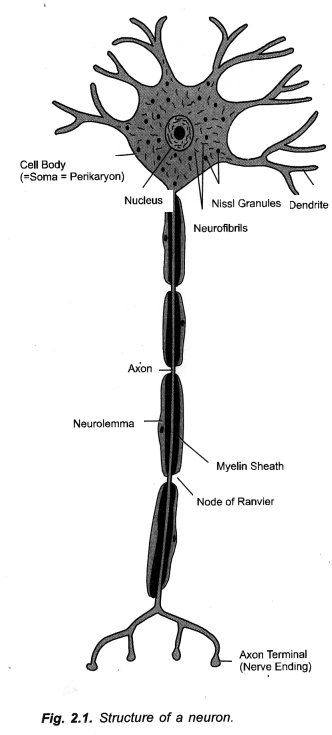
Functions:
- Dendrites: Picking up sensations and transmitting the same to cell body.
- Cell Body:
- Sustaining structure and function of dendrites and axon,
- Functioning as passage¬way for transmission of sensation or impulse to axon.
- Axon: Carrying impulse to another neuron, muscle, gland and organ. A single impulse can be transmitted to several structures with the help of axon terminals.
Question 13.
What are the major parts of the brain ? Mention the function of different parts.
Answer:
Major Parts of Brain
Fore-Brain: Olfactory lobes (2), Cerebral hemispheres (2) or cerebrum, Diencephalon.
Mid-Brain: Cerebral peduncles, Corpora quadrigemina.
Hind Brain: Pons, Cerebellum, Medulla oblongata.
Functions
- Olfactory Lobes: Receive sensation of smell from olfactory epithelium and relay the same to temporal lobes of cerebral hemispheres.
- Cerebral Hemispheres:
- Frontal Lobes: Centres of intelligence, control of movements and facial muscles, speech.
- Parietal Lobes: Taste and cutaneous sensations with some components of speech.
- Temporal Lobes: Hearing, smell, recall of audiovisual memory, some components of speech.
- Occipital Lobes: Sight.
- Diencephalon: Hypothalamus part regulates activity of smooth muscles and functions as control centre for hunger, thirst, fatigue, sleep, sweating, temperature and emotions. Pituitary gland and pineal gland are components of diencephalon.
- Corpora Quadrigemina: Superior – sight reflexes. Inferior – auditory reflexes.
- Cerebellum: Controls posture and equilibrium.
- Pons: Part of respiratory centre.
- Medulla Oblongata: Centre for reflexes, blood pressure, heart beat, breathing.
Question 14.
What constitutes the central and peripheral nervous systems ? How are the components of central nervous system protected?
(CCE 2012)
Answer:
Central Nervous System (CNS): It is hollowed part of nervous system that lies along the mid-dorsal part of the body. It has two parts, brain (located in the head) and spinal cord (located in the trunk).
Peripheral Nervous System (PNS): It is soild lateral part of nervous system that develops from CNS and connects different parts of the body with CNS. Peripheral nervous system has two components, voluntary and involuntary. Voluntary peripheral nerous system is under the control of will. It consists of cranial nerves from brain and spinal nerves from spinal cord. Involuntary peripheral nervous system works independent of will. It develops from some cranial and spinal nerves. Involuntary peripheral nervous system is also called autonomic nervous system. It has two parts, sympathetic (for emergency) and parasympathetic (for moderation). They control the functioning of various internal body parts.
Protection of Brain: Brain box or Cranium, meninges and cerebrospinal fluid.
Protection of Spinal Cord: Vertebral Column, meninges and cerebrospinal fluid.
Question 15.
Mention one function for each of these hormones.
(a) Thyroxine
(b) Insulin
(c) Adrenaline
(d) Growth hormone
(e) Testosterone. (CCE 2010, 2013, 2015)
Answer:
(a) Thyroxine: Regulates metabolism of carbohydrates, fats and proteins, release of energy and body activity.
(b) Insulin: Regulates blood glucose by its absorption in liver, muscles (for formation of glycogen) and individual cells (for metabolic activity).
(c) Adrenaline: For meeting an emergency by increasing heart rate and supply of blood to various concerned organs.
(d) Growth Hormone (GH) or Somatotrophic Hormone: Regulates growth and development of the body through anabolic activity for growth of bones, muscles and visceral organs.
(e) Testosterone (Male Sex Hormone): Controls changes in body associated with puberty in males (beard, moustache, low pitch voice, increased growth of bones and muscles).
Question 16.
Name the various plant hormones. Also give their physiological effects on plant growth and development. (CCE 2016)
Answer:
Five types — auxin, gibberelin, cytokinin, ethylene and abscisic acid.
Auxin: Cell enlargement, root formation, apical dominance, inhibition of abscission, fruit growth.
Gibberellin: Growth in stem and leaves, higher fruit yield, overcoming dormancy.
Cytokinin: Essential for cell division, differentiation, prevention of senescence and overcoming apical dominance.
Ethylene: Promotes transverse growth, fruit ripening and overcoming dormancy of some parts.
Abscisic Acid (ABA): Induces dormancy, senescence and abscission, checking excessive activity of growth promoting hormones, closure of stomata under water stress.
Question 17.
What are reflex actions ? Give two examples. Explain a reflex arc.
Answer:
Definition: Reflex actions seem to have evolved quite early in the physiology of animals when complex neuron network for processing had not been evolved. Even after evolution of processing centres, reflex actions have continued to persist because of their more efficiency for quick responses.
Two Examples:
- On being pricked or coming in contact with hot surface, hand is withdrawn even before pain is perceived (by brain),
- Wider openin0 of pupil in dim light and its narrowing in strong light.
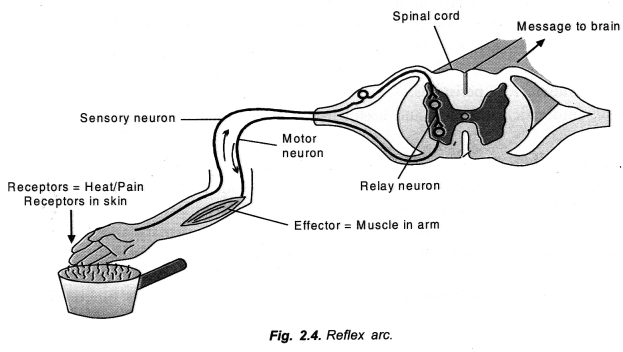
Question 18.
“Nervous and hormonal systems together perform the function of control and coordination in human being.” Justify the statement.
Answer:
Both nervous system and hormonal (or endocrine) system are involved in control, regulation and coordination of body parts. Nervous system is connected to receptors of all senses. Information obtained from sensory organs is passed rapidly to CNS for interpretation.
On the basis of interpretation, a message is sent to effector organ or organs (muscles, glands, etc.). The rate of information or impulse transfer is very high, some 100m/sec. Every action and activity is well coordinated as the information is sent to all the regions required for that action. The action can be voluntary (under the will) or involuntary. Passage of food in the alimentary canal is due to an involuntary movement of alimentary canal called peristalsis. Picking up food and placing it inside the mouth is a voluntary movement. Both these movements are highly coordinated by nervous system.
Nervous system is also connected with the functioning of endocrine or hormonal system. The endocrine system functions at the biochemical level while nervous system functions at the physical and physiological level. For their functioning endocrine glands pour their secretion into blood which transports them to all parts of the body. Target cells have receptors for picking up the hormones and working as per hormonal stimulus. There is a feedback system which determines the requirement of hormones and the activity of endocrine glands. Other stimuli are also involved for coordinated functioning. Presence of food in the stomach stimulates its wall to secrete hormone gastrin. Gastrin stimulates gastric glands to pour gastric juice over the food. As the partially digested food passes into duodenum, the latter forms hormone secretin which induces passage of bile and pancreatic juice into duodenum.
Joint working of both the systems is observed during an emergency. Both sympathetic nervous system and adrenal glands prepare the body for meeting the emergency. There is higher rate of heart beat, more blood supply to cardiac and skeletal muscles and higher rate of breathing for quicker oxygenation of blood.
Question 19.
How does chemical co-ordination take place in animals ?
Answer:
In animals, chemical coordination is achieved through the agency of hormones which function as chemical messengers or informational molecules. Hormones are secreted by ductless glands in response to specific conditions or nervous stimulation. Timing and amount of a hormone released are regulated by feed-back mechanism. After a meal, sugar level of blood rises. It is detected by pancreas. Pancreas responds by producing hormone insulin from (3-cells of islets of Langerhans. Insulin causes glucose to be absorbed by all cells as well as get stored in liver and muscles in the form of glycogen. As the level of glucose falls in blood, insulin secretion is reduced.
Question 20.
Why the flow of signals in a synapse is from axonal end of one neuron to dendrite end of another neuron but not the reverse ?
Answer:
As the electrical impulse reaches the axon terminal in the region of axon-dendrite synapse, it stimulates the exocytosis of vesicles containing neurotransmitter (e.g. acetylcholine). Neurotransmitter attaches to the chemoreceptor sites of the membrane covering the dendrite end of synapse. It creates a new impulse that travels through cell body and axon of the second neuron. At synapse, the axon end does not contain any chemoreceptor sites so that reverse flow of electrochemical impulses is not possible.
Hope given NCERT Exemplar Solutions for Class 10 Science Chapter 7 Control and Coordination are helpful to complete your science homework.
If you have any doubts, please comment below. Learn Insta try to provide online science tutoring for you.